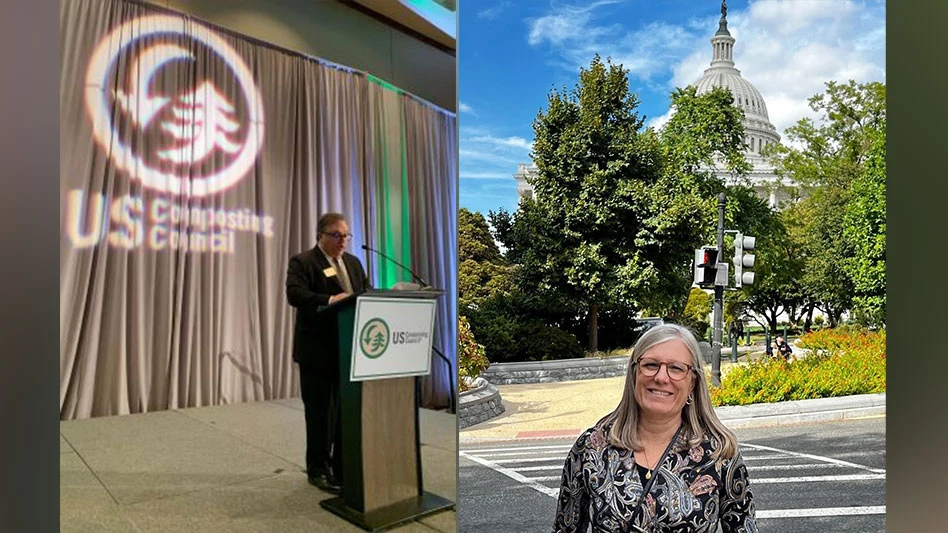
Photo courtesy of USPS
The United States Postal Service (USPS) has announced new sustainability targets for its 2030 fiscal year that involve reducing greenhouse gas emissions and waste at every level of its operations. Additionally, the USPS says its 10-year Delivering for America transformation and modernization plan provides the foundation for the organization to continuously improve the sustainability of its operations.
Its sustainability targets are centered around the core areas of climate action, the circular economy and environmental awareness.
The plan focuses on specific initiatives to continue to reduce $5 billion in operating costs, including reducing regional and local network transportation by at least $2.5 billion by aggregating volume in fewer facilities and moving mail and packages regionally in an integrated manner to eliminate thousands of trips each day and use less air transportation. It also plans to reduce processing, distribution and delivery costs by at least $2.5 billion by insourcing previously outsourced operations, consolidating operations out of random buildings, modernizing facilities, reorganizing operating plans and schedules, adding more sortation equipment and improving operating tactics to increase throughput, gain productivity and increase asset utilization.
The USPS says these initiatives will reduce carbon emissions significantly by eliminating wasteful and unnecessary operating activities.
Regarding climate action, the USPS says it is reducing greenhouse gas emissions by moving freight from air to ground transportation, optimizing delivery routes for trucks and carriers and procuring reduced-emission and zero-emission vehicles. By fiscal year 2030, USPS seeks to reduce Scope 1 and Scope 2 greenhouse gas emissions by 40 percent and reduce Scope 3 greenhouse gas emissions by 20 percent.
The USPS says it is focused on strengthening the circular economy by diverting waste from landfills and through the sustainable acquisition of materials. Additionally, it will increase procurement of on-site renewable energy and renewable energy certificates.
By its fiscal year 2030, the USPS says it seeks to divert 75 percent of waste from landfills, increase recycled content in packaging to 74 percent, increase package recyclability to 88 percent, increase renewable energy use to 10 percent and expand environmental awareness.
Additionally, the USPS says it plans to ensure environmental policy requirements are communicated and incorporated into operations and provide on-site and online training and tools that align with policy and regulatory requirements to all relevant USPS employees.
Other actions the USPS has taken in the past three years to enhance sustainability across the organization include starting to roll out the nation’s largest electric vehicle fleet. This year, USPS will begin to introduce at least 66,000 battery electric-powered delivery vehicles into its fleet and is building a nationwide network of electric vehicle charging stations to rapidly deploy these emission-free vehicles. USPS says it also will continue to explore the feasibility of achieving 100 percent electrification for the delivery vehicle fleet. In Atlanta in January, the Postal Service debuted the first of tens of thousands of electric charging stations that will eventually be used to power zero-emission USPS delivery trucks.
“The improvements we need to achieve in sustainability are an integral outgrowth of the broader modernization efforts we have undertaken through our 10-year Delivering for America plan,” Postmaster General and Chief Executive Officer Louis DeJoy says. “As we transform our operating processes and invest in new automation, new technologies and upgraded facilities and vehicles, we will generate significant efficiencies that reduce our costs, minimize waste across all functions of our operations and slash our carbon footprint.”
In addition to accomplishing these operational cost and sustainability initiatives, the USPS says it plans to grow its business by several billion dollars.
These new goals will help the USPS better meet the needs of Americans, Jennifer Beiro-Réveillé, the senior director of environmental affairs and corporate sustainability, says.
“Our customers and partners expect the Postal Service to be efficient and environmentally responsible, and I’m proud that our leadership team has developed meaningful sustainability goals and aligned them with our operational efficiency, service improvement and revenue growth initiatives,” she adds. “These new targets help advance our commitment to being the greenest way for customers to mail and ship across the country.”
In 2023, the USPS named four executives to a new panel to create a long-term environmental strategy, with Postmaster General Louis DeJoy serving as chair of the USPS Environmental Council. The Environmental Council will oversee implementing the environmental goals and noted objectives.
Latest from Waste Today
- EPA takes steps to require MSW incinerators to report toxic chemical emissions
- Food waste composting system coming to Canadian province next year
- Updated: CAA submits final draft program plan in Oregon
- Enviri names new president of Harsco Environmental business
- Bureau of Labor: Fatality rate increased for waste collection in 2023
- Atlanta awarded $3.2M to support electric vehicle fleet transition
- McNeilus to spotlight collection innovation at CES 2025
- Baltimore nonprofit opens zero-waste facility





